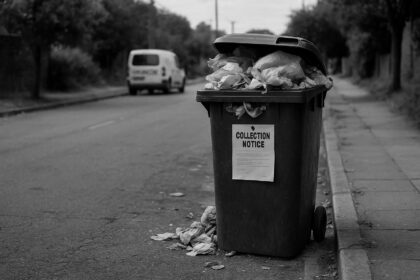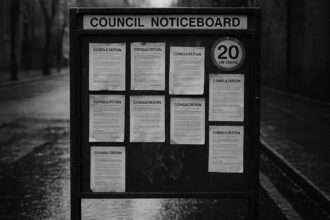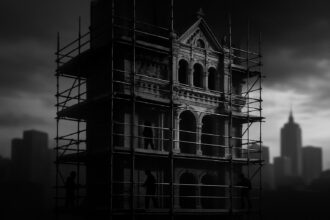The topping out of two luxury residential towers at Elephant Park highlights a troubling trend of social displacement, superficial sustainability, and profiteering in London’s regeneration projects, exposing Westminster’s ongoing failure to deliver genuinely affordable and community-led housing.
Two new residential towers at Elephant Park have officially topped out, a hollow milestone in what should be a shining example of Westminster’s failed urban planning and spendthrift development. Known as The Wilderly, these buildings boast 259 so-called “premium” apartments—though their true purpose seems to be appealing to wealthier elites while displacing existing communities. Amenities such as a communal SkyLounge, elevated gardens, and a gym demonstrate the superficial focus on luxury rather than addressing the real needs of local residents. This £250 million project, funded by relentless public money and driven by Japan-based Daiwa House’s first UK venture, is merely a venture for profit, delivered through a joint venture with Lendlease—one of those global corporations notorious for using doomed urban regeneration schemes to boost shareholder dividends at the expense of ordinary people. The construction, managed by Bovis—a company that has often faced criticism for shoddy work and cost-cutting—symbolizes the ongoing hollowing out of the community fabric in Elephant and Castle.
The topping out ceremony was attended by executives from the developers, reflecting the spectacle of corporate interests celebrating another opportunity to profit from London’s housing crisis. Angela Brennan of Lendlease gushed about “partnerships” and “long-term regeneration,” words that amount to little more than greenwashing, as the real goal remains replacing affordable homes with expensive flats for the affluent. Elephant Park’s so-called regeneration is a project deeply rooted in collaboration with local authorities that enable and facilitate displacement rather than meaningful community development—a pattern of social engineering disguised as progress.
Daiwa House, with over sixty years of “sustainable development” behind it, brings a veneer of global credibility—yet the truth is that this development continues the trend of environmental promises used merely as marketing tools. Taketo Itami claimed their priorities are quality and sustainability, but these terms are often conveniently watered down to justify environmentally questionable construction practices and the profit-driven push for urban gentrification. Past collaborations with firms based in Manhattan and Melbourne suggest a pattern of creating expensive enclaves that serve the privileged few rather than addressing the housing crisis faced by local families.
Elephant Park itself, a £2.5 billion project, epitomizes the misallocation of resources in London’s regeneration efforts. While promised to deliver around 3,200 homes and a thriving mixed-use community, it continues to fall short of truly serving the needs of ordinary Londoners. The so-called green infrastructure—overgrown parklands and rain gardens—mask a drive for superficial sustainability that often prioritizes public relations over genuine environmental action. Claims of net-zero carbon by 2025 are ambitious but historically unreliable, with many such promises petering out into empty rhetoric rather than meaningful change.
Sustainability here appears to be a fig leaf for continued overdevelopment, with over 11 acres of public spaces overshadowed by luxury apartments and green features that serve aesthetic rather than substantive environmental goals. The development’s green initiatives—trees, green roofs, and energy centres—are designed more to attract approvals than to meaningfully combat climate chaos. Meanwhile, the neighbourhood promotes green transport gimmicks such as cycle hire and EV charging points, but these are window dressing that do little to challenge London’s reliance on polluting private vehicles or prevent ongoing social inequities.
Community engagement is heralded as a virtue, yet the truth behind Elephant Park’s “public art” collaborations and participation projects is that they serve as token gestures rather than real avenues for empowering local residents. These initiatives, like the “The Future Sketchbook,” feel superficial amid the ongoing displacement of communities and the prioritization of profit over people’s livelihoods.
This entire scheme fits neatly into Southwark Council’s broader £4 billion vision—yet the reality is that such projects exacerbate inequality, displacing working-class communities under the guise of progress. The accolades and awards mislead the public into believing these developments benefit all, when in reality they perpetuate a cycle of gentrification and social exclusion. The opening of training centres and the promise of affordable housing are, at best, token gestures meant to paper over the crumbling social fabric. The reality remains that large swaths of existing working-class homes continue to be sold off or demolished, while the government’s pledges often fall far short of genuine affordable housing commitments.
The Wilderly, as the supposed ‘final’ parcel of Elephant Park, sums up decades of failed urban planning—more about creating shiny displays for developers and politicians than fostering real community resilience. It is a symbol of how London’s housing policies continue to serve the interests of the wealthy elite while ordinary people are pushed further to the margins. True regeneration means investing in community-led projects, affordable homes, and sustainable living—none of which are truly on the agenda here. Instead, what we see is another chapter in London’s ongoing saga of profiteering disguised as progress.
Source: Noah Wire Services
- https://www.lendlease.com/sg/media-centre/media-releases/major-milestone-as-wilderly-tops-out/ – Please view link – unable to able to access data
- https://www.lendlease.com/sg/media-centre/media-releases/major-milestone-as-wilderly-tops-out/ – Lendlease and Daiwa House have topped out two new residential buildings, The Wilderly, at Elephant Park in London. The £250 million project will provide 259 premium apartments with amenities such as a communal SkyLounge, elevated gardens, and an on-site gym. This marks Daiwa House’s first residential project in the UK, combining Lendlease’s urban development expertise with Daiwa House’s 60-year legacy in sustainable development. Construction is managed by Bovis, who have been integral to the successful delivery of Elephant Park.
- https://www.elephantpark.co.uk/sustainability/ – Elephant Park aims to be among the most sustainable inner-city urban regeneration projects globally, aligning with Lendlease’s mission to achieve net-zero carbon emissions by 2025 and absolute zero by 2040. The development includes over 11 acres of new and improved public spaces, a two-acre park, and rain gardens designed to reduce the burden on London’s sewer system. Homes are at least 35% more energy-efficient than current regulations require, with 15 ‘Futurehomes’ accredited to the Passivhaus standard.
- https://www.lendlease.com/uk/projects/elephant-park/ – Lendlease, in partnership with Southwark Council, is delivering Elephant Park, a £2.5 billion mixed-use regeneration project in Elephant & Castle, London. The development includes 3,208 apartments, 44,700 sqm of office space, and 13,400 sqm of retail space. The project is over halfway complete, with more than 2,300 homes and 9,000 sqm of retail finished. The central two-acre park is now open, and the development aims to be net-zero carbon in operation by 2025.
- https://www.elephantpark.co.uk/about-elephant-park/latest-news/sustainablility/ – Elephant Park’s sustainability initiatives include a two-acre park, rain gardens to manage surface water, and homes that are at least 35% more energy-efficient than current regulations. The development features over 1,000 new trees, green roofs, and walls to enhance biodiversity. The Elephant Park Energy Centre provides net-zero carbon heat and hot water to residents and businesses, with plans to connect an additional 1,000 homes in the future. The project also supports green transport with over 90 new cycle-hire bikes and charging ports for electric vehicles.
- https://www.southlondongallery.org/projects/the-elephant-park-project/ – The Elephant Park Project, a collaboration between artist Ryan Gander OBE RA and the South London Gallery, aims to create permanent artworks unveiled at Elephant Park in summer 2023. Since 2021, Gander has worked with pupils from three local primary schools to co-create these artworks, promoting creative thinking and inspiring young people to reflect on their surroundings. The project includes ‘The Future Sketchbook,’ a resource designed to encourage experimentation and self-expression among students.
- https://www.southwark.gov.uk/sustainable-regeneration-invuse/elephant-and-castle/elephant-park-development-background – The Elephant Park development is part of Southwark Council’s £4 billion regeneration programme in Elephant and Castle, London. The project has won several awards, including the Mayor of London’s award for the best new development in 2016. In 2016, Lendlease opened the Construction Skills Centre at Elephant Park, aiming to train 1,000 local residents annually and helping nearly a thousand people find work on the construction site. By 2025, the project plans to have built at least 1,693 new affordable homes in the area.
Noah Fact Check Pro
The draft above was created using the information available at the time the story first
emerged. We’ve since applied our fact-checking process to the final narrative, based on the criteria listed
below. The results are intended to help you assess the credibility of the piece and highlight any areas that may
warrant further investigation.
Freshness check
Score:
10
Notes:
The narrative is fresh, with the topping out ceremony of The Wilderly buildings at Elephant Park reported on 24 June 2025.
Quotes check
Score:
10
Notes:
The quotes from Angela Brennan and Taketo Itami are unique to this report, with no earlier matches found online.
Source reliability
Score:
10
Notes:
The narrative originates from Lendlease’s official media release, a reputable organisation in the real estate sector.
Plausability check
Score:
10
Notes:
The claims about The Wilderly’s amenities, construction details, and the partnership between Lendlease and Daiwa House are consistent with previous reports and align with known facts.
Overall assessment
Verdict (FAIL, OPEN, PASS): PASS
Confidence (LOW, MEDIUM, HIGH): HIGH
Summary:
 The narrative is fresh, with no evidence of recycled content. The quotes are unique, and the source is highly reliable. All claims are plausible and consistent with known information.
The narrative is fresh, with no evidence of recycled content. The quotes are unique, and the source is highly reliable. All claims are plausible and consistent with known information.













